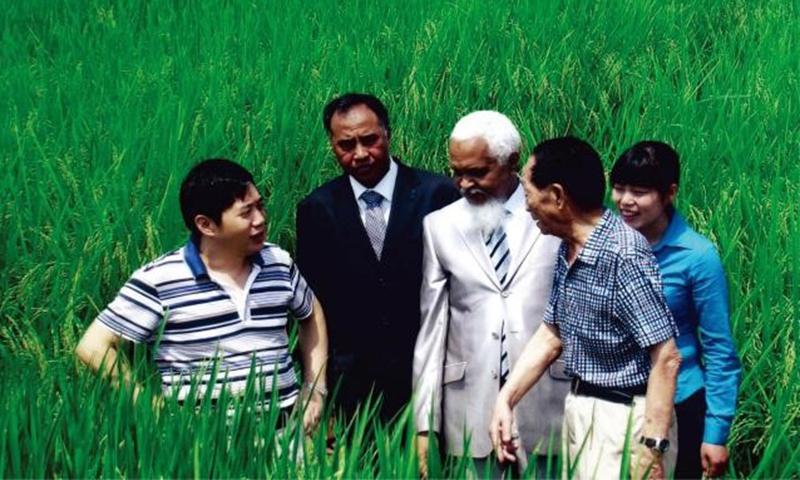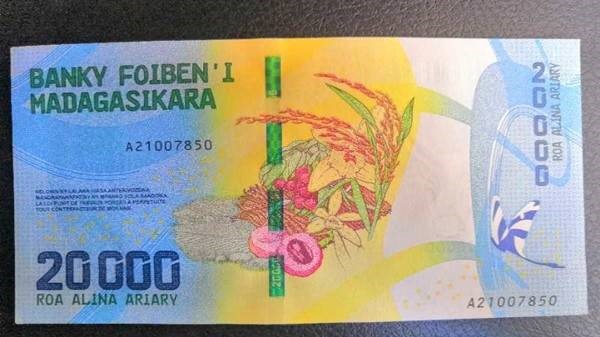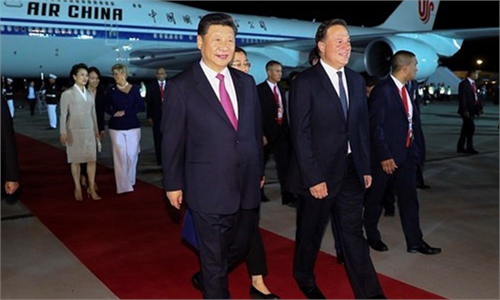In the vast rice fields of Mahitsy, Madagascar, local farmers are harvesting rice. They gather the roots of the ripe crops in one hand and cutting them skillfully with a sickle in the other. Then they lift the crops high above and beat them on the ground repeatedly, for the ripe grains to fall off one by one. With the sound of "bang,bang", this beautiful and fertile land is filled with the joy of harvest.
These crops are hybrid rice from China. Before they were introduced into Madagascar, the country, with 80 percent of its population living on agriculture and two-thirds of its arable land growing rice, still sought a solution to the low yield of local rice.
Madagascar's Minister of Agriculture, Livestock, and Fisheries Fanomezantsoa Lucien Ranarivelo once identified the lack of quality seeds and technical training as two bottlenecks for rice plantation in the country. As part of the solution, a hybrid rice demonstration center for Madagascar was established in August 2007. It was undertaken by China's Hunan Academy of Agricultural Sciences, and was one of the 10 major agricultural demonstration zones to be built by China for African countries. It was a concrete effort by the Chinese government to fulfill its solemn commitments made at the Forum on China-Africa Cooperation in 2006.
Madagascar, located to the east of the African continent and in the west of the Indian Ocean, is the largest island in Africa and the fourth largest island in the world. It has tropical rainforest climate along its southeastern coast, tropical highland climate in its central part, and tropical steppe climate in the west. Such diverse weather patterns are vastly different from the climate in China. How can Chinese hybrid rice thrive in Madagascar? The answer was implied by Yuan Longping in the preface of his book Extraordinary Rice (Feichangdao), "'The real Tao does not stay unchanged.' Likewise, each strain of hybrid rice must adapt to its unique living environment. There is no rice strain that can grow in all kinds of environment. Innovation and change are always needed to help new rice strains adapt to new environment."
In order to find high-yielding seeds that can grow in the various climates of Madagascar and localize the plantation of hybrid rice, Hu Yuefang, a Chinese expert from the Hunan Academy of Agricultural Sciences, spent 10 years in almost all rice-growing areas in Madagascar. Under the guidance of Academician Yuan Longping, Hu and his team successfully cultivated three high-yielding hybrid rice strains that fit the local climate and soil conditions. The strains show stronger resistance to diseases and insects and greater potential of yields, and were soon approved by the local government, representing an important step in the localization of hybrid rice in Madagascar.

Yuan Longping and his Madagascan friends in a hybrid rice field
"Teaching one how to fish is better than giving him fish." For the Madagascan people to grow localized high-yielding hybrid rice, the Chinese project team hired many local people to share with them planting techniques, from sowing to transplanting, from weeding to pest control and harvesting. Hu Yuefang said, "It is important to adopt a meticulous and science-based training approach. We show them what to do in every step and pay great attention to detail." In this spirit, the Chinese experts toured the test fields on motorbikes and pickup trucks everyday to tutor the local staff in the field.
On 9 December 2019, at the opening ceremony of the first Forum on China-Africa Agricultural Cooperation, Yuan Longping made a brief speech, where he announced that the planting area (of hybrid rice) in Madagascar reached 20,000 hectares and the average yield per hectare 8 tons, an increase of 100 to 300 percent compared with the local varieties. Madagascar today has Africa's largest area of hybrid rice cultivation with the highest yield. It is also the first African country that has set up a full industrial chain of hybrid rice production.
The success of hybrid rice in Madagascar has also been a story of improved livelihood for many Madagascan people. Njala, a local employee at the Mahitsy Hybrid Rice High-Yield Demonstration Training Base, had this story to tell: "I have grown a lot of hybrid rice in my own field, and the harvest has been very good. I have been working with the company for 10 years, and my income keeps growing. I have saved some money over the years and started to build a new house." Randall, the "man of hybrid rice" in Alafah Village, Ambatondrazaka, successfully planted hybrid rice after attending training courses and knowledge-sharing workshops. With the money he made, he has moved into a red brick house, quite admired by other villagers. One could hardly believe that only a few years ago he and his family were huddling in a small thatched hut. In 2010, Randall planted one hectare of hybrid rice and harvested more than 7 tons of rice, a yield three times that of the local rice. By the end of 2014, his planting area had exceeded 20 hectares. More than 20 farmers in the same village followed him to plant hybrid rice, scaling up the planting area to more than 200 hectares.
"Thanks to a seed, people of Madagascar have had their rice bags and wallets stuffed". In Madagascar today, rice is seen as the best gift to guests. In August 2017, Sahuri, Director-General of the Plant Protection Department of the Ministry of Agriculture, Animal Husbandry and Fisheries of Madagascar, and his delegation gave Yuan Longping, father of hybrid rice, such a present - the new Madagascan banknote of the largest denomination with a bunch of hybrid rice printed on its back.
"Rice is the most important food crop for the people of Madagascar. The planting area of the Chinese hybrid rice in Madagascar is expanding. The people of Madagascar no longer suffer from hunger! To thank you, the people of Madagascar have chosen rice as the new pattern on our banknotes." Sahuri said with excitement.

The new version of Madagascan note bears Chinese hybrid rice
Today, "hybrid rice" researchers are still working hard in the fields of Madagascar. Their efforts were not hindered by the COVID pandemic. In May 2019, the only overseas branch of the China National Hybrid Rice R&D Center was established in Madagascar. The China-FAO South-South Cooperation Programme Madagascar Project was launched at the end of the same year. The story of China-Africa friendship behind hybrid rice is still unfolding, not only in Madagascar, but also in Cameroon, Burundi, Senegal and other African countries.



